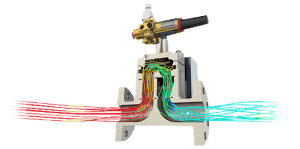Introduction to Computational Fluid Dynamics with SOLIDWORKS Flow Simulation
 When the products you design involve liquid or gas flow, how can you test their performance for real-world conditions? This is where computational fluid dynamics (CFD) with SOLIDWORKS Flow Simulation software comes in.
When the products you design involve liquid or gas flow, how can you test their performance for real-world conditions? This is where computational fluid dynamics (CFD) with SOLIDWORKS Flow Simulation software comes in.
SOLIDWORKS Flow Simulation enables you to run “what if” scenarios and efficiently analyze the effects of fluid flow, heat transfer and related forces on or through components. This allows you to compare design variations quickly to make better decisions so you can create products with superior performance. Read on to learn more about CFD with SOLIDWORKS Flow Simulation.
What is Computational Fluid Dynamics?
Engineers use a number of analysis methods to understand the impact of the world around us on their designs. A key analysis method is CFD, which is used to analyze and solve problems that involve the impact of fluid flow, including liquids or gases.
CFD is applied to a wide range of engineering problems in many industries, including high-tech electronics cooling, aerospace and aerodynamics analysis, industrial systems design, engine and combustion analysis, and many others.
What is SOLIDWORKS Flow simulation?
SOLIDWORKS Flow is a general-purpose fluid flow and heat transfer simulation tool integrated with SOLIDWORKS 3D CAD. You can use this CFD solution to simulate both low-speed and supersonic flows.
SOLIDWORKS Flow simulation enables true concurrent engineering and brings the critical impact of fluid flow analysis and heat transfer into your workflow to ensure your designs will perform optimally. Additionally, you can simulate the effects of fans and rotating components on the fluid flow as well as component heating and cooling.
This list provides a high-level summary of CFD capabilities using SOLIDWORKS Flow simulation:
- Internal/external liquid and gas flow
- Free surface flow
- Non-Newtonian flows
- Low speed to supersonic flows
- Fans and rotating components
- Conjugate heat transfer
- Electronics cooling module
- Pressure and temperature transfer to SOLIDWORKS Simulation for structural analysis
To learn more about how you can apply SOLIDWORKS Flow Simulation to your design environment, check out the video below. This video shows three separate case studies, including:
- Minimizing pressure loss in a piping system
- Designing electronics to maximize cooling
- Reducing drag and wind noise in automotive components
This video will give you an understanding of how SOLIDWORKS Flow can improve your development process and is the first in a 4-part webinar series showcasing SOLIDWORKS Flow Simulation.
Related Articles
SOLIDWORKS Flow Simulation Tutorial: Fluid Flow Problems
Introduction to SOLIDWORKS Simulation Webinar: What is Finite Element Analysis?
How to Change Units in SOLIDWORKS Simulation
About the Author
 Christa Prokos is a marketing manager at Fisher Unitech. She researches and writes about the latest business trends and technologies impacting manufacturers, including 3D printing, SOLIDWORKS 3D CAD design and product data management tools, product lifecycle management, virtual reality, and the Internet of Things. Christa has worked as a high tech marketing and communications professional since 2000.
Christa Prokos is a marketing manager at Fisher Unitech. She researches and writes about the latest business trends and technologies impacting manufacturers, including 3D printing, SOLIDWORKS 3D CAD design and product data management tools, product lifecycle management, virtual reality, and the Internet of Things. Christa has worked as a high tech marketing and communications professional since 2000.

 Blog
Blog 